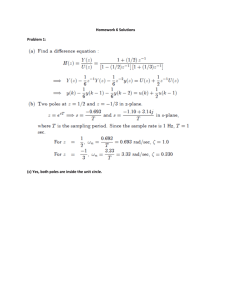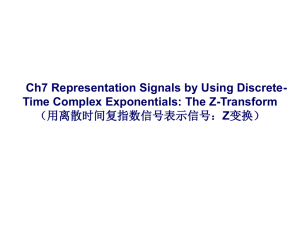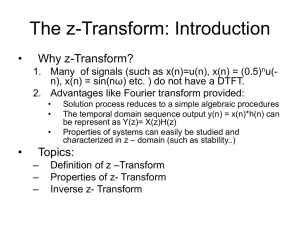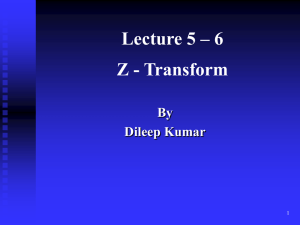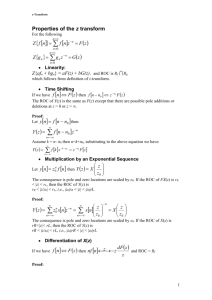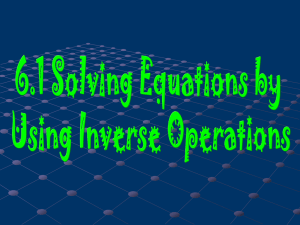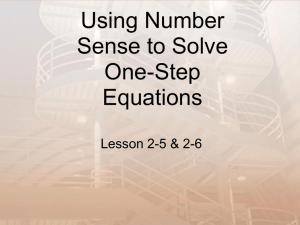Lecture-21-22: Introduction to Digital Control
advertisement
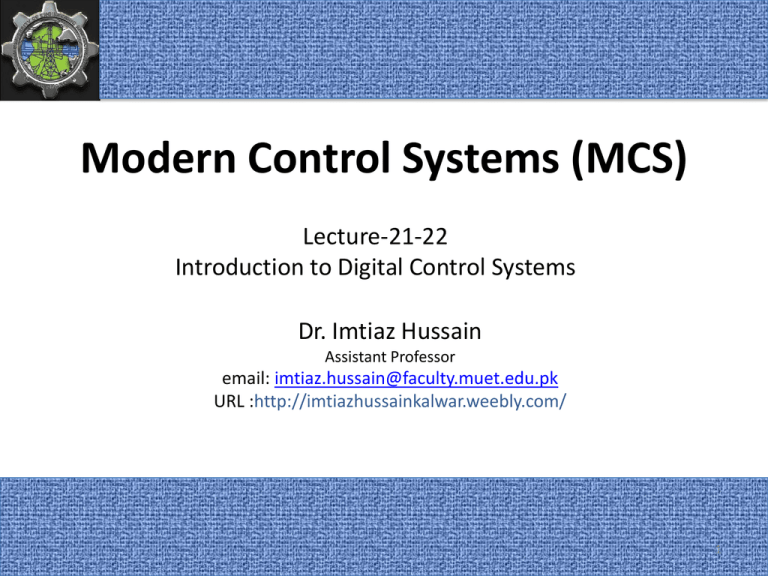
Modern Control Systems (MCS)
Lecture-21-22
Introduction to Digital Control Systems
Dr. Imtiaz Hussain
Assistant Professor
email: imtiaz.hussain@faculty.muet.edu.pk
URL :http://imtiazhussainkalwar.weebly.com/
1
Lecture Outline
• Introduction
• Difference Equations
• Review of Z-Transform
• Inverse Z-transform
• Relations between s-plane and z-plane
• Solution of difference Equations
2
Recommended Book
• M.S. Fadali, “Digital Control
Engineering – Analysis and
Design”, Elsevier, 2009. ISBN: 13:
978-0-12-374498-2
Professor of Electrical Engineering
Area of Specialization: Control Systems
3
Introduction
• Digital control offers distinct advantages over analog
control that explain its popularity.
• Accuracy: Digital signals are more accurate than their
analogue counterparts.
• Implementation Errors: Implementation errors are
negligible.
• Flexibility: Modification of a digital controller is possible
without complete replacement.
• Speed: Digital computers may yield superior
performance at very fast speeds
• Cost: Digital controllers are more economical than
analogue controllers.
4
Structure of a Digital Control System
5
Examples of Digital control Systems
Closed-Loop Drug Delivery System
6
Examples of Digital control Systems
Aircraft Turbojet Engine
7
Difference Equation vs Differential Equation
• A difference equation expresses the change in
some variable as a result of a finite change in
another variable.
• A differential equation expresses the change in
some variable as a result of an infinitesimal
change in another variable.
8
Differential Equation
• Following figure shows a mass-spring-damper-system. Where y is
position, F is applied force D is damping constant and K is spring
constant.
𝐹 𝑡 = 𝑚𝑦 𝑡 + 𝐷 𝑦 𝑡 + 𝐾𝑦(𝑡)
• Rearranging above equation in following form
1
𝐷
𝐾
𝑦 𝑡 = 𝐹 𝑡 − 𝑦 𝑡
𝑦(𝑡)
𝑚
𝑚
𝑚
9
Differential Equation
1
𝐷
𝐾
𝑦 𝑡 = 𝐹 𝑡 − 𝑦 𝑡
𝑦(𝑡)
𝑚
𝑚
𝑚
• Rearranging above equation in following form
𝐹(𝑡)
1
𝑚
𝑦
𝑑𝑡
−
𝑦
𝑑𝑡
𝑦
𝐷
𝑚
−
𝐾
𝑚
10
Difference Equation
1
𝐷
𝐾
𝑦(𝑘 + 2) = 𝐹(𝑘) − 𝑦(𝑘 + 1) 𝑦(𝑘)
𝑚
𝑚
𝑚
𝐹(𝑘)
1
𝑚
𝑦(𝑘 + 2)
1
𝑧
−
𝑦(𝑘 + 1)
1
𝑧
𝑦(𝑘)
𝐷
𝑚
−
𝐾
𝑚
11
Difference Equations
• Difference equations arise in problems where the
independent variable, usually time, is assumed to have
a discrete set of possible values.
𝑦 𝑘 + 𝑛 + 𝑎𝑛−1 𝑦 𝑘 + 𝑛 − 1 + ⋯ + 𝑎1 𝑦 𝑘 + 1 + 𝑎0 𝑦 𝑘
= 𝑏𝑛 𝑢 𝑘 + 𝑛 + 𝑏𝑛−1 𝑢 𝑘 + 𝑛 − 1 + ⋯ + 𝑏1 𝑢 𝑘 + 1 + 𝑏0 𝑢 𝑘
• Where coefficients 𝑎𝑛−1 , 𝑎𝑛−2 ,… and 𝑏𝑛 , 𝑏𝑛−1 ,… are
constant.
• 𝑢(𝑘) is forcing function
12
Difference Equations
• Example-1: For each of the following difference equations,
determine the order of the equation. Is the equation (a)
linear, (b) time invariant, or (c) homogeneous?
1.
𝑦 𝑘 + 2 + 0.8𝑦 𝑘 + 1 + 0.07𝑦 𝑘 = 𝑢 𝑘
2.
𝑦 𝑘 + 4 + sin(0.4𝑘)𝑦 𝑘 + 1 + 0.3𝑦 𝑘 = 0
3.
𝑦 𝑘 + 1 = −0.1𝑦 2 𝑘
13
Z-Transform
• Difference equations can be solved using classical methods
analogous to those available for differential equations.
• Alternatively, z-transforms provide a convenient approach for
solving LTI equations.
• The z-transform is an important tool in the analysis and design
of discrete-time systems.
• It simplifies the solution of discrete-time problems by
converting LTI difference equations to algebraic equations and
convolution to multiplication.
• Thus, it plays a role similar to that served by Laplace
transforms in continuous-time problems.
14
Z-Transform
• Given the causal sequence {u0, u1, u2, …, uk}, its ztransform is defined as
𝑈 𝑧 = 𝑢𝑜 + 𝑢1 𝑧 −1 + 𝑢2 𝑧 −2 + 𝑢𝑘 𝑧 −𝑘
∞
𝑢𝑘 𝑧 −𝑘
𝑈 𝑧 =
𝑘=0
• The variable z −1 in the above equation can be
regarded as a time delay operator.
15
Z-Transform
• Example-2: Obtain the z-transform of the
sequence
u
k k 0
1, 1, 3, 2, 0, 4, 0, 0, 0,...
16
Relation between Laplace Transform and Z-Transform
• Given the impulse train representation of a discrete-time signal
𝑢∗ 𝑡 = 𝑢𝑜 𝛿 𝑡 + 𝑢1 𝛿 𝑡 − 𝑇 + 𝑢2 𝛿 𝑡 − 2𝑇 + ⋯ + 𝑢𝑘 𝛿 𝑡 − 𝑘𝑇
𝑢(𝑡)
𝑢∗ (𝑡)
∞
𝑢∗ 𝑡 =
𝑢𝑘 𝛿 𝑡 − 𝑘𝑇
𝑢(𝑡)
𝑘=0
𝑈(𝑠)
𝑢∗ (𝑡)
𝑈 ∗ (𝑠)
• The Laplace Transform of above equation is
𝑈 ∗ 𝑠 = 𝑢𝑜 + 𝑢1 𝑒 −𝑠𝑇 + 𝑢2 𝑒 −2𝑠𝑇 + ⋯ + 𝑢𝑘 𝑒 −𝑘𝑠𝑇
∞
𝑈∗ 𝑠 =
• Let z be defined by
𝑢𝑘 𝑒 −𝑘𝑠𝑇
𝑘=0
𝑧 = 𝑒 𝑠𝑇
17
Conformal Mapping between s-plane to z-plane
𝑧 = 𝑒 𝑠𝑇
• Where 𝑠 = 𝜎 + 𝑗𝜔. Then 𝑧 in polar coordinates is given by
𝑧 = 𝑒 (𝜎+𝑗𝜔)𝑇
𝑧 = 𝑒 𝜎𝑇 𝑒 𝑗𝜔𝑇
• Therefore,
𝑧 = 𝑒 𝜎𝑇
∠𝑧 = 𝜔𝑇
18
Conformal Mapping between s-plane to z-plane
• We will discuss following cases to map given points on s-plane
to z-plane.
– Case-1: Real pole in s-plane (𝑠 = 𝜎)
– Case-2: Imaginary Pole in s-plane (𝑠 = 𝑗𝜔)
– Case-3: Complex Poles (𝑠 = 𝜎 + 𝑗𝜔)
𝑠 − 𝑝𝑙𝑎𝑛𝑒
𝑧 − 𝑝𝑙𝑎𝑛𝑒
19
Conformal Mapping between s-plane to z-plane
• Case-1: Real pole in s-plane (𝑠 = 𝜎)
• We know
𝑧 = 𝑒 𝜎𝑇
∠𝑧 = 𝜔𝑇
• Therefore
𝑧 = 𝑒 𝜎𝑇
∠𝑧 = 0
20
Conformal Mapping between s-plane to z-plane
Case-1: Real pole in s-plane (𝑠 = 𝜎)
𝑧 = 𝑒 𝜎𝑇
∠𝑧 = 𝜔𝑇
When 𝑠 = 0
𝑧 = 𝑒 0𝑇 = 1
∠𝑧 = 0𝑇 = 0
𝑠=0
1
𝑠 − 𝑝𝑙𝑎𝑛𝑒
𝑧 − 𝑝𝑙𝑎𝑛𝑒
21
Conformal Mapping between s-plane to z-plane
Case-1: Real pole in s-plane (𝑠 = 𝜎)
𝑧 = 𝑒 𝜎𝑇
∠𝑧 = 𝜔𝑇
When 𝑠 = −∞
𝑧 = 𝑒 −∞𝑇 = 0
∠𝑧 = 0
0
−∞
𝑠 − 𝑝𝑙𝑎𝑛𝑒
𝑧 − 𝑝𝑙𝑎𝑛𝑒
22
Conformal Mapping between s-plane to z-plane
Case-1: Real pole in s-plane (𝑠 = 𝜎)
𝑧 = 𝑒 𝜎𝑇
∠𝑧 = 𝜔𝑇
Consider 𝑠 = −𝑎
𝑧 = 𝑒 −𝑎𝑇
∠𝑧 = 0
0
−𝑎
𝑠 − 𝑝𝑙𝑎𝑛𝑒
1
𝑧 − 𝑝𝑙𝑎𝑛𝑒
23
Conformal Mapping between s-plane to z-plane
• Case-2: Imaginary pole in s-plane (𝑠 = ±𝑗𝜔)
• We know
𝑧 = 𝑒 𝜎𝑇
∠𝑧 = 𝜔𝑇
• Therefore
𝑧 =1
∠𝑧 = ±𝜔𝑇
24
Conformal Mapping between s-plane to z-plane
Case-2: Imaginary pole in s-plane (𝑠 = ±𝑗𝜔)
𝑧 = 𝑒 𝜎𝑇
∠𝑧 = 𝜔𝑇
Consider 𝑠 = 𝑗𝜔
𝑧 = 𝑒 0𝑇 = 1
∠𝑧 = 𝜔𝑇
1
𝑠 = 𝑗𝜔
𝜔𝑇
−1
1
−1
𝑠 − 𝑝𝑙𝑎𝑛𝑒
𝑧 − 𝑝𝑙𝑎𝑛𝑒
25
Conformal Mapping between s-plane to z-plane
Case-2: Imaginary pole in s-plane (𝑠 = ±𝑗𝜔)
𝑧 = 𝑒 𝜎𝑇
∠𝑧 = 𝜔𝑇
When 𝑠 = −𝑗𝜔
𝑧 = 𝑒 0𝑇 = 1
∠𝑧 = −𝜔𝑇
1
−1
−𝜔𝑇
1
𝑠 = −𝑗𝜔
−1
𝑠 − 𝑝𝑙𝑎𝑛𝑒
𝑧 − 𝑝𝑙𝑎𝑛𝑒
26
Conformal Mapping between s-plane to z-plane
Case-2: Imaginary pole in s-plane (𝑠 = ±𝑗𝜔)
𝑧 = 𝑒 𝜎𝑇
∠𝑧 = 𝜔𝑇
𝜔
When 𝑠 = ±𝑗
𝑇
𝑧 = 𝑒 0𝑇 = 1
∠𝑧 = ±𝜋
𝝎𝑻 = 𝝅
𝜔
𝑗
𝑇
1
𝜋
−1
−𝑗
𝑠 − 𝑝𝑙𝑎𝑛𝑒
𝜔
𝑇
1
−1
𝑧 − 𝑝𝑙𝑎𝑛𝑒
27
Conformal Mapping between s-plane to z-plane
• Anything in the Alias/Overlay region in the S-Plane will be
overlaid on the Z-Plane along with the contents of the strip
𝜋
between ±𝑗 .
𝑇
28
Conformal Mapping between s-plane to z-plane
• In order to avoid aliasing, there must be nothing in this region, i.e. there
must be no signals present with radian frequencies higher than w p/T,
or cyclic frequencies higher than f = 1/2T.
• Stated another way, the sampling frequency must be at least twice the
highest frequency present (Nyquist rate).
29
Conformal Mapping between s-plane to z-plane
Case-3: Complex pole in s-plane (𝑠 = 𝜎 ± 𝑗𝜔)
𝑧 = 𝑒 𝜎𝑇
∠𝑧 = 𝜔𝑇
𝑧 = 𝑒 𝜎𝑇
∠𝑧 = ±𝜔𝑇
1
−1
1
−1
𝑠 − 𝑝𝑙𝑎𝑛𝑒
𝑧 − 𝑝𝑙𝑎𝑛𝑒
30
Mapping regions of the s-plane onto
the z-plane
31
Mapping regions of the s-plane onto
the z-plane
32
Mapping regions of the s-plane onto
the z-plane
33
34
35
Example-3
• Map following s-plane poles onto z-plane assume
(T=1). Also comment on the nature of step
response each case.
1.
2.
3.
4.
5.
𝑠 = −3
𝑠 = ±4𝑗
𝑠 = ±𝜋𝑗
𝑠 = ±2𝜋𝑗
𝑠 = −10 ± 5𝑗
36
z-Transforms of Standard Discrete-Time Signals
• The following identities are used repeatedly to derive several
important results.
𝑛
𝑘=0
𝑛+1
1
−
𝑎
𝑎𝑘 =
,
1−𝑎
∞
𝑎𝑘
𝑘=0
1
=
,
1−𝑎
𝑎≠1
𝑎 ≠1
37
z-Transforms of Standard Discrete-Time Signals
• Unit Impulse
1,
𝛿 𝑘 =
0,
𝑘=0
𝑘≠0
• Z-transform of the signal
𝛿 𝑧 =1
38
z-Transforms of Standard Discrete-Time Signals
• Sampled Step
𝑘≥0
𝑘<0
1,
𝑢 𝑘 =
0,
• or
𝑢 𝑘 = 1, 1, 1,1, …
𝑘≥0
• Z-transform of the signal
𝑛
𝑈 𝑧 = 1 + 𝑧 −1 + 𝑧 −2 + 𝑧 −3 + ⋯ + 𝑧 −𝑘 =
𝑧 −𝑘
𝑘=0
𝑈 𝑧 =
1
1−𝑧 −1
=
𝑧
𝑧−1
𝑧 <1
39
z-Transforms of Standard Discrete-Time Signals
• Sampled Ramp
𝑘,
𝑟 𝑘 =
0,
𝑘≥0
𝑘<0
𝑟 𝑘
……
0
• Z-transform of the signal
𝑧
𝑈 𝑧 =
𝑧−1
1
2
3
𝑘
2
40
z-Transforms of Standard Discrete-Time Signals
• Sampled Parabolic Signal
𝑎𝑘 ,
𝑢 𝑘 =
0,
𝑘≥0
𝑘<0
• Then
𝑛
𝑈 𝑧 = 1 + 𝑎𝑧 −1 + 𝑎2 𝑧 −2 + 𝑎3 𝑧 −3 + ⋯ + 𝑎𝑘 𝑧 −𝑘 =
(𝑎𝑧)−𝑘
𝑘=0
𝑈 𝑧 =
1
1−𝑎𝑧 −1
=
𝑧
𝑧−𝑎
𝑧 <1
41
Inverse Z-transform
1. Long Division: We first use long division to
obtain as many terms as desired of the ztransform expansion.
2. Partial Fraction: This method is almost identical
to that used in inverting Laplace transforms.
However, because most z-functions have the
term z in their numerator, it is often convenient
to expand F(z)/z rather than F(z).
42
Inverse Z-transform
• Example-4: Obtain the inverse z-transform of
the function
𝑧+1
𝐹 𝑧 = 2
𝑧 + 0.2𝑧 + 0.1
• Solution
• 1. Long Division
43
Inverse Z-transform
𝑧+1
𝐹 𝑧 = 2
𝑧 + 0.2𝑧 + 0.1
• 1. Long Division
• Thus
𝐹 𝑧 = 0 + 𝑧 −1 + 0.8𝑧 −2 − 0.26𝑧 −3 + ⋯
• Inverse z-transform
𝑓 𝑘 = 0,
1,
0.8,
−0.26,
…
44
Inverse Z-transform
• Example-5: Obtain the inverse z-transform of
the function
𝑧+1
𝐹 𝑧 = 2
𝑧 + 0.3𝑧 + 0.02
• Solution
• 2. Partial Fractions
𝐹 𝑧
𝑧+1
=
𝑧
𝑧(𝑧 2 + 0.3𝑧 + 0.02)
𝐹 𝑧
𝑧+1
=
𝑧
𝑧(𝑧 2 + 0.1𝑧 + 0.2𝑧 + 0.02)
45
Inverse Z-transform
𝐹 𝑧
𝑧+1
=
𝑧
𝑧(𝑧 + 0.1)(𝑧 + 0.2)
𝐹 𝑧
𝐴
𝐵
𝐶
= +
+
𝑧
𝑧 𝑧 + 0.1 𝑧 + 0.2
F ( z)
1
1
A z
F (0)
50
z z 0
0.1 0.2 0.02
B ( z 0.1)
F ( z)
1
z 1
0.1 1
( z 0.1)
90
z z 0.1
z ( z 0.1)( z 0.2) z 0.1 (0.1)(0.1 0.2)
F ( z)
1
z 1
0.2 1
C ( z 0.2)
( z 0.2)
40
z z 0.2
z ( z 0.1)( z 0.2) z 0.2 (0.2)(0.2 0.1)
46
Inverse Z-transform
𝐹 𝑧
50
90
40
=
−
+
𝑧
𝑧
𝑧 + 0.1 𝑧 + 0.2
90𝑧
40𝑧
𝐹 𝑧 = 50 −
+
𝑧 + 0.1 𝑧 + 0.2
• Taking inverse z-transform (using z-transform table)
𝑓 𝑘 = 50𝛿 𝑘 − 90 −0.1
𝑘
+ 40 −0.2
𝑘
47
Inverse Z-transform
• Example-6: Obtain the inverse z-transform of
the function
𝑧
𝐹 𝑧 =
(𝑧 + 0.1)(𝑧 + 0.2)(𝑧 + 0.3)
• Solution
• 2. Partial Fractions
48
Z-transform solution of Difference Equations
• By a process analogous to Laplace transform solution of
differential equations, one can easily solve linear
difference equations.
1.
The equations are first transformed to the z-domain (i.e., both
the right- and left-hand side of the equation are ztransformed) .
2.
Then the variable of interest is solved.
3.
Finally inverse z-transformed is computed.
49
Z-transform solution of Difference Equations
• Example-7: Solve the linear difference equation
3
1
𝑥 𝑘 + 2 − 𝑥 𝑘 + 1 + 𝑥 𝑘 = 1(𝑘)
2
2
• With initial conditions 𝑥 0 = 1, 𝑥 1 =
5
2
Solution
• 1. Taking z-transform of given equation
𝑧2𝑋
𝑧 −
𝑧2𝑥
3
1
𝑧
0 − 𝑧𝑥 1 − 𝑧𝑋 𝑧 + 𝑋 𝑧 =
2
2
𝑧−1
• 2. Solve for X(z)
[𝑧 2 −
3
1
𝑧
5 3
2
𝑧 + ]𝑋 𝑧 =
+ 𝑧 + ( − )𝑧
2
2
𝑧−1
2 2
50
Z-transform solution of Difference Equations
• Then
3
1
𝑧
5 3
2
[𝑧 − 𝑧 + ]𝑋 𝑧 =
+ 𝑧 + ( − )𝑧
2
2
𝑧−1
2 2
2
𝑧[1 + (𝑧 + 1)(𝑧 − 1)]
𝑧3
𝑋 𝑧 =
=
(𝑧 − 1)(𝑧 − 1)(𝑧 − 0.5)
𝑧 − 1 2 (𝑧 − 0.5)
• 3. Inverse z-transform
𝑋 𝑧
𝑧2
𝐴
=
=
𝑧
𝑧 − 1 2 (𝑧 − 0.5)
𝑧−1
2𝑧
𝑋(𝑧) =
𝑧−1
2+
𝐵
𝐶
+
𝑧 − 1 𝑧 − 0.5
𝑧
2 + 𝑧 − 0.5
𝑥(𝑘) = 2𝑘 + (0.5)𝑘
51
To download this lecture visit
http://imtiazhussainkalwar.weebly.com/
END OF LECTURES-21-22
52
